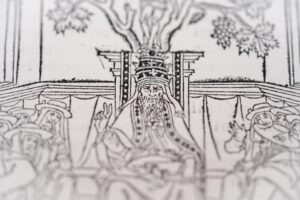Mysterious writing. No author. Enigmatic etchings that don’t make sense. I’m not referring to some artifact from Egypt or Easter Island. I’m describing an intriguing, ancient, and rather odd site in Aberdeenshire, Scotland.
Two stone pillars with a muddled backstory stand in someone’s garden. We do not know when, where, and how these came to be, only that their discovery was complete happenstance.
Background
In 1804, the Earl of Aberdeen found two odd vertical stones around where he was trying to build a road. They were uprooted and placed in the garden of a local antiquarian, Alexander Gordon, who lived on an estate called Newton House. The stones themselves most likely date to the 6th and 7th centuries.
In a letter dated Sept. 10, 1885, Lord Aberdeen wrote to a correspondent: “The stone, at the time to which I refer, might have been passed by thousands without characters being at all observed. The rugged surface and the rude manner in which the letters are inscribed, rendered them little likely to attract notice…”
The Newton Stone is one of two pillars. The first pillar stands approximately two meters tall, while the second is slightly taller. According to Scottish heritage organizations, the symbols etched into the first are distinctly Pictish. They show a serpent and a Z-rod alongside a double disc.
This particular symbol has appeared on other Pictish sites throughout Scotland. Little is known of the Picts, who lived in the region throughout the early Middle Ages. A few carved stones are almost all we have to go on.

Stone with the serpent symbol and Z-rod. Photo: Pinterest
The mysterious second stone
The second stone is not so straightforward, which is the mystery we focus on. The writing on the left side of the pillar is possibly Ogham, an ancient Irish or Brittonic language long extinct. It resembles runes, as its letters contain long lines with slashes and dashes along them. The Ogham script possibly spells out a name, Ethernan, whose context is also unknown.
However, most intriguing is the right half of the stone. This features carvings of an unknown script and odd symbols including a swastika. We have no key to decipher the meaning. Perhaps, as some have suggested, it’s simply gibberish.
Writers have published the script in books since 1814, in the hope of catching a linguist’s attention. And that it did.
Linguistic puzzles
Solving the “unknown script,” as it’s officially called, is the key to understanding these stones. Five ancient languages have been proposed: debased Latin, Greek, Gaelic, Phoenician, and Gnostic symbolism. Other proposals include mixtures of Hebrew, Canaanite, Hittite, and Bactrian.
George Moore, author of Ancient Stone Pillars of Scotland, wrote, “I was struck with the general resemblance of the characters to those I had seen on certain coins known as Bactrian…Arian and Pali rock records of Northwestern India, and recognized as Buddhistic…”
An English antiquarian, Thomas Wright, suggested that the unknown script was debased in Latin. His translation read, “hie facet Constantinus” or “here lies Constantinus, the son of,” which would make the stone a headstone.

Illustration of the stones. Photo: John Stuart
A popular proposal suggested a Phoenician origin and translated the text as: “To Eshmun, God of Health, by this monumental stone, may the wandering Exile of me, thy servant, go up in never-ceasing memorial, even the record of Han Thanet Zenaniah, Magistrate, who is saturated with sorrow.”
“Eshmun” refers to the Phoenician god of healing, whose corresponding symbol is a serpent. It sounds promising. Could this have been a healing stone of sorts?
Theories
With regard to the debased Latin proposal, even though the Roman armies left Britain in the 5th century, some stayed and built a life there. Perhaps this was the work of one of those individuals.
Could it be some variant of Pictish that linguistic historians have not yet discovered? There are very few examples of Pictish “writing” out there, which does not give us much to go on.
The Phoenician hypothesis gained traction in some circles, and the serpent symbol was one of the driving pieces of evidence. However, the Picts also used the serpent symbol often. There is another Pictish stone with this same serpent carving in Aberdeenshire called the Brandsbutt Stone. Because of the close proximity to the Newton Stone, did the Picts mean to create a pilgrimage route that connected the various stones?

The Brandsbutt Stone has similarities to the Newton Stone in its Pictish symbolism. Photo: Julie Beynon Burnett/Shutterstock
A hoax?
The Phoenician theory is intriguing but farfetched. How did Phoenician script end up on a stone in Aberdeenshire, Scotland? Some proponents have suggested that the Celts descended from Phoenicians.
The other ancient languages — Greek, Hittite, Canaanite, etc. — are likewise improbable. This brings us to the next theory. Archaeologist C.A. Gordon claims it is a hoax inspired by the Rosetta Stone, found only five years before the Newton Stone.
Due to the inconsistency of the unknown script, academics agree that some carvings were added later on, as late as the 18th and 19th centuries. “The incomprehensibility of the inscription was due to it being a forgery perpetrated in the early years of the 19th century,” wrote Gordon.
Finally, the stones could have started out as Pictish in origin before someone carved their own symbols into them, thus the confusion. It could have been a practical joke or a perverse attempt to puzzle.
Conclusion
If you want to solve this mystery and have some coin to spare, the Newton House and its property are currently on sale for £1,650,000. You can then own the stones themselves. This is a chance to unlock this mystery once and for all.
However, from what we know so far, this could either be a hoax or the vandalization of a rare Pictish archaeological find. Whatever the case, it does not diminish its intrigue. Until we get a firm grasp of the language, that one Newton Stone continues to puzzle us all.






